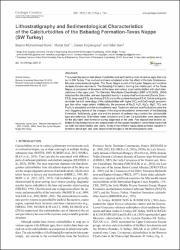Lithostratigraphy and Sedimentological Characteristics of the Calciturbidites of the Babadag Formation-Tavas Nappe (SW Turkey)
Künye
Kore, B. M., Gül, M., Küçükuysal, C., & Sari, B. (2021). Lithostratigraphy and Sedimentological Characteristics of the Calciturbidites of the Babadağ Formation-Tavas Nappe (SW Turkey). Geologia Croatica, 74(1), 1-20.Özet
The Lycian Nappes contain slices of ophiolites and sedimentary rocks of various ages that crop out in SW Turkey. They evolved and were emplaced under the effect of the Late Cretaceous-Miocene compressional regime. The Tavas Nappe is part of the Lycian Nappes and contains Jurassic-Eocene sediments. The Babadag Formation, forming the middle part of the Tavas Nappe, is composed of limestone at the base and various sized calciturbidites with chert intercalations in the upper part. The Standard Microfacies Classification (SMF of FLUGEL, 2004) indicates that the entire unit was deposited mainly in a deep-shelf environment (Facies Zone - FZ-2), deep-sea (FZ-1), toe of slope (FZ-3) and on the continental slope (FZ-4). Calcite and quartz dominate the bulk mineralogy of the calciturbidites with higher SiO2 and CaO weight percentages than other major oxides. Additionally, the presence of Na2O, K2O, Al2O3, MgO, TiO2 and Fe2O3 is associated with the local sediment input. Tectonism and sea level fluctuations were the main triggering factors of the changes in the original depositional environment of the Babadag Formation. Additionally, grain size and the amount of sediment input control the calciturbidite type and extension. Si enriched water circulation and Si and Ca substitution were responsible for the abundant chert formation during diagenesis of the units. Post depositional tectonic activities during transportation and emplacement of the nappes resulted in calcite filled cracks that cut both the calciturbidites and cherts. Study of the different nappe slices provides valuable information about syn- and post- depositional changes of the lithostratigraphic units.


















